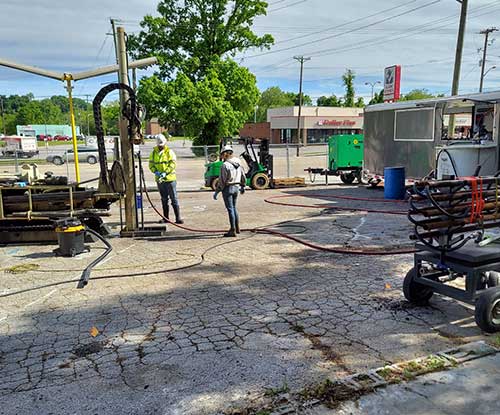ABSTRACT
Trap & Treat® BOS 200+® was applied using direct push technology (DPT) methods at a former retail gasoline site in Knoxville, TN. Since installation, there has been a 57-99% reduction in total BTEX, a 42-99% reduction in naphthalene, and an average increase of almost 200% in dissolved CO2 over the project monitoring period. The State of Tennessee issued a No Further Action (NFA) status for the project in 2022.


BOS 200+® Application Earns No Further Action Status
PROJECT SNAPSHOT
Key Dates
• 2020 – September – HRSC survey completed
• 2020 – October – RDC completed
• 2021 – May BOS 200+® injection event
• 2022 – May NFA Issued
Treatment Area (Figure 1): 3,500 ft2
Lithology: Stiff to soft clay
Depth to Water Table: 17 ft below ground surface (bgs)
Treatment Interval: 10 to 34 ft bgs
Contaminant(s): Benzene, Toluene, Ethylbenzene, Total Xylenes (BTEX), and Naphthalene
Implementation Method: Top-Down DPT; High-Energy Injection
CHALLENGES
• Predominately clay site
• Suspected immobile LNAPL (hydrocarbon soil concentrations > Csat)
• Incomplete Conceptual Site Model (CSM)
OBJECTIVES
To mitigate LNAPL and reduce hydrocarbon concentrations below the Site-Specific Clean-up Levels (SSCLs) to expedite site closure.
• LNAPL mitigation (Note: LNAPL was not detected in the monitoring wells but was suspected to be present based upon OIP results and saturated soil analytical data)
• TDEC Soil SSCL: 3.8 mg/kg benzene
• TDEC Groundwater SSCL: 0.885 mg/L benzene
APPROACH
Initially, High Resolution Site Characterization (HRSC) using the combined Optical Image Profiler (OIP)/Hydraulic Profiling Tool (HPT) was completed for qualitative assessment and delineation in September 2020. Following the HRSC work and the data interpretation, a Remedial Design Characterization (RDC) was performed to quantitatively determine the overall lateral and vertical extent of the speciated compounds and total contaminant mass within the source area and the dissolved plume.
High-density soil and groundwater sampling was completed in October 2020. Samples were collected from 76 soil sample intervals in 6 borings, and 8 groundwater wells were sampled. All samples were analyzed at the Remediation Products, Inc. (RPI) Project Support Laboratory in Golden, CO, at no cost to the project.
Using the data from the RDC, a surgical injection design was developed for the site using BOS 200®+. Coupling of the soil and groundwater data during the remedial design process allowed AST to consider the total contaminant demand within the treatment area. Remedial implementation occurred in May 2021 and consisted of 107 injection points (10 gals. per shot, 12.5-25 lbs. per injection) and 20,300 lbs. of BOS 200® injected.
RESULTS
The data for this site was divided into lower (1 – 9.9 mg/L total BTEX) and upper (>10 mg/L total BTEX) baseline concentration ranges.
Lower (1 – 9.9 mg/L) total BTEX in groundwater at baseline
• 96 – 99% reduction in total BTEX
• 98 – 99% reduction in naphthalene
• 223 – 297% increase in dissolved CO2
Upper (> 10 mg/L) total BTEX in groundwater at baseline
• 57 – 92% reduction in total BTEX
• 42 – 97% reduction in naphthalene
• 53 – 217% increase in dissolved CO2
Given that the areas with the higher baseline hydrocarbon concentrations in groundwater also had higher concentrations in saturated soil mass, lower decreases in groundwater concentrations were observed over the monitoring period. However, during the last sampling event, sulfate concentrations ranging f rom 407 to 1,000 mg/L were observed, which will sustain the biological degradation of the petroleum hydrocarbons adsorbed within the activated carbon matrix. Ultimately, this system will reduce the dissolved concentrations to the levels similarly observed in the “Lower total BTEX” monitoring wells.









